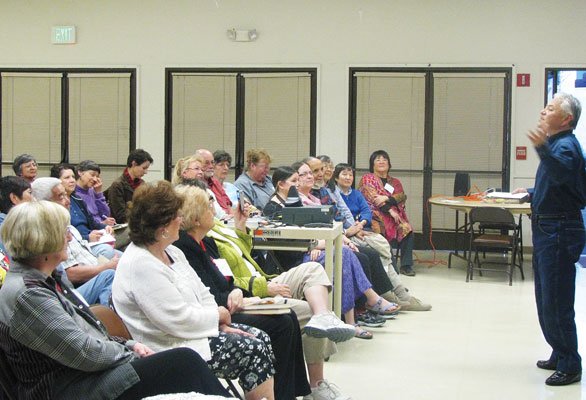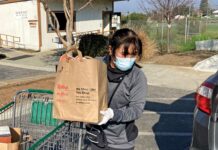Peach farmer and rural scribe David Mas Masumoto often tells the
story of how all good farms have a junk pile. He said it usually
consists of
”
odd machine parts, old equipment, and discarded history. The
pile stays put, planted as if it is part of the landscape, growing
with each decade.
”
Peach farmer and rural scribe David Mas Masumoto often tells the story of how all good farms have a junk pile. He said it usually consists of “odd machine parts, old equipment, and discarded history. The pile stays put, planted as if it is part of the landscape, growing with each decade.”
No one intends to grow a junk pile, but it naturally happens on the farm.
After speaking at a farm conference in Wisconsin one time, an old farmer in overalls approached him to talk about his own junk pile.
“Out here we don’t call them ‘junk piles,'” he announced.
Masumoto expected him to use some other expression, such as “bone pile.”
Instead, he said, “Out here we call them…” He leaned in closer to Masumoto, as if whispering a carefully guarded secret. “We call them ‘inventory.'”
The large audience gathered at Gilroy’s Senior Center reacted with enthusiasm to Masumoto’s humor last Thursday evening when he spoke of the challenges and rewards of being a small organic farmer in today’s high pressure corporate farming climate.
Most days Masumoto works until sunset on his 80-acre organic farm south of Fresno, where he grows organic peaches, nectarines and grapes. His wife, Marcy, and their two children also work the farm, where they grow 13 varieties of peaches, each with its own unique flavor. A third generation farmer, Masumoto told the Gilroy audience that most Americans born in the last 50 years don’t know what a peach should taste like.
Masumoto worries that in the future, there will be generations who have never tasted anything other than the high-sugar, flavorless peaches cultivated so that they can be picked when they’re still hard and unripe in order to make them suitable for packing and shipping long distances. He fears that people will lose even the memory of what a perfect peach should taste like, the stunning, honeyed flavor of a juicy heirloom peach that has been passed down for generations.
Whenever he’s not farming, he spends time on his “literary farm,” squeezing in time to write almost everyday. He writes to get the word out about sustainable and environmentally healthy growing.
“We believe in the power of stories, stories that capture the meaning of our work and stories that convey our passion,” Masumoto said. “I farm stories. My main story is about trying to grow the perfect peach.”
He wonders, “When we breed out flavor, are we breeding out nutrients?”
Masumoto is a family friend of my husband’s cousins, Saburo and Marion Masada, and one of the things I most appreciate about him is his ability to articulate and share his experience of farming in a way that most farmers cannot. My 83-year-old Japanese-American father-in-law, Hideo Teraji, who learned to farm more than 50 years ago by sitting in his father’s lap on the tractor, has rarely said more than a sentence or two about farming, but I know that Masumoto gives voice to many of his feelings.
In his latest book, “Wisdom of the Last Farmer”, Masumoto tells the story of helping his father relearn to farm after a stroke and what Masumoto has learned of the natural connections between generations, between fathers and sons, and the value of hands-on, age-old wisdom that is fast disappearing from our modern high-speed world.
Masumoto said that being brought to Gilroy by Friends of Gilroy Library, Gilroy Library Commission, AAUW, Gilroy Writer’s Project, Vision Literacy, and Gilroy Library Book Club made this one of the most co-sponsored events at which he has ever been featured. He called it “a wonderful reflection of the community we have here.”
When Martha Stewart sent a team to photograph Masumoto’s glowing globes of gold late one hot afternoon last summer, it was still over 100 degrees. Not a breath of air stirred the tablecloth that transformed an old beat-up table into a beautiful prop out in the middle of Masumoto’s peach trees.
“You know, the photo would really look much better if there was a slight breeze,” the photographer said.
But with no electricity out in the field for a fan, the team had to be creative.
Masumoto took off his wide-brimmed hat that is one of the secrets of his youthful-looking skin despite many hours spent farming in the hot sun. He began waving it back and forth, creating a breeze off camera, and the table skirt began to gently sway.
In many ways, Masumoto waving his hat out in the field to generate wind is a perfect microcosmic illustration of the hands-on and personal approach of the farming he hopes will pass the true flavor of the peach from his father on down to generations to come.
More on Masumoto
To learn more about author David Mas Masumoto:
-Check out his books, “Epitaph for a Peach, Four Seasons on my Family Farm” and “Wisdom of the Last Farmer, Harvesting Legacies from the Land”
-See Masumoto’s farm in the June issue of Martha Stewart Living
-Visit the Masumoto Family Farm online at www.masumoto.com/index.htm













